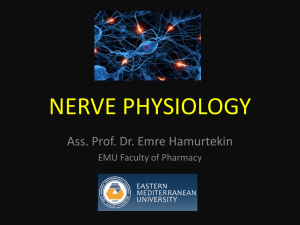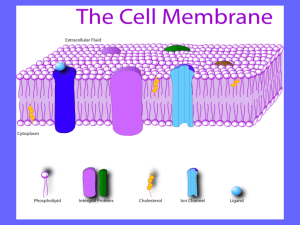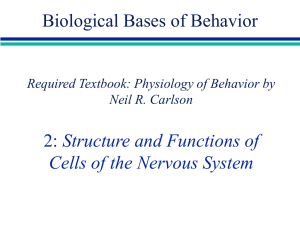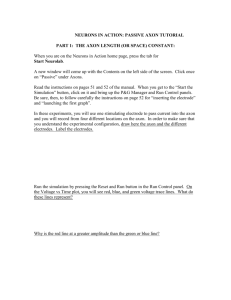Cell practice questions - Madison Public Schools
advertisement
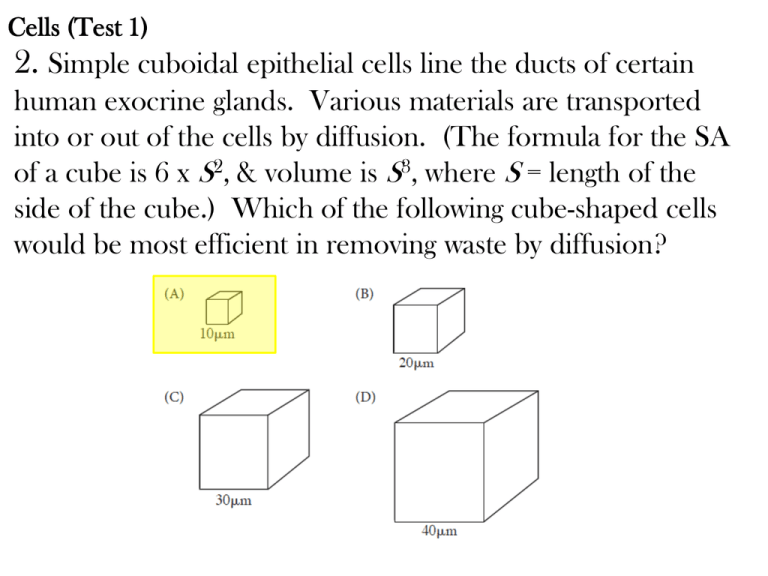
Cells (Test 1) 2. Simple cuboidal epithelial cells line the ducts of certain human exocrine glands. Various materials are transported into or out of the cells by diffusion. (The formula for the SA of a cube is 6 x S2, & volume is S3, where S = length of the side of the cube.) Which of the following cube-shaped cells would be most efficient in removing waste by diffusion? Cells (Test 1) 5. A pathogenic bacterium has been engulfed by a phagocytic cell as part of the nonspecific (innate) immune response. Which of the following illustrations best represents the response? Cells (Test 1) 12. Paramecia are unicellular protists that have contractile vacuoles to remove excess intracellular water. In an experimental investigation, paramecia were placed in salt solutions of increasing osmolarity. The rate at which the contractile vacuole contracted to pump out excess water was determined and plotted against osmolarity of the solutions, as shown in the graph. Which of the following is the correct explanation? a. At higher osmolarity, lower rates of contracted are required because more salt diffused into the paramecia. b. The contraction rate increases as the osmolarity decreases because the amount of water entering by osmosis increases. c. The contractile vacuole is less efficient in solutions of high osmolarity because of the reduced amount of ATP produced from cellular respiration. d. In an isotonic salt solution, there is no diffusion of water into or out of the paramecia, so the contraction rate is zero. Cells (Test 1) 17. The endocrine system incorporates feedback mechanisms that maintain homeostasis. Which of the following demonstrates negative feedback by the endocrine system? a. During labor, the fetus exerts pressure on the uterine wall, inducing the production of oxytocin, which stimulates uterine wall contraction. The contractions cause the fetus to further push on the wall, increasing production of oxytocin. b. After a meal, blood glucose levels become elevated, stimulating beta cells of the pancreas to release insulin in the blood. Excess glucose is then converted to glycogen in the liver, reducing blood glucose levels. c. At high elevation, atmospheric oxygen is more scare. In response to signals that oxygen is low, the brain decreases an individual’s rate of respiration to compensate for the difference. d. A transcription factor binds to the regulatory region of a gene, blocking the binding of another transcription factor required for expression. Cells (Test 1) 23. An individual’s humoral response to a particular antigen differs depending on whether or not the individual has been previously exposed to that antigen. Which of the following graphs properly represents the humoral immune response when an individual is exposed to the same antigen more than once? Cells (Test 1) 30. A human kidney filters about 200 liters of blood each day. Approximately 2 liters of liquid and nutrient waste are excreted as urine. The remaining fluid and dissolved substances are reabsorbed and continue to circulate throughout the body. Antidiuretic hormone (ADH) is secreted in response to reduced plasma volume. ADH targets the collecting ducts in the kidney, stimulating the insertion of aquaporins into their plasma membranes and an increased reabsorption of water. If ADH secretion is inhibited, which of the following would initially result? a. The number of aquaporins would increase in response to the inhibition of ADH. b. The person would decrease oral water intake to compensate for the inhibition of ADH. c. Blood infiltration would increase to compensate for the lack of aquaporins. d. The person would produce greater amounts of dilute urine. Cells (Test 1) 31. The diagram shows a developing worm embryo at the four-cell stage. Experiments have shown that when cell 3 divides, the anterior daughter cell gives rise to muscle and gonads and the posterior daughter cell gives rise to the intestine. However, if the cells of the embryo are separated from one another early during the four-cell stage, no intestine will form. Other experiments have shown that if cell 3 and 4 are recombined after the initial separation, the posterior daughter of cell 3 will once again give rise to normal intestine. Which of the following is the most plausible explanation for these findings? a. A cell surface protein on cell 4 signals cell 3 to induce formation of the worm’s intestine. b. The plasma membrane of cell 4 interacts with the plasma membrane of the posterior portion of cell 3, causing invaginations that become microvilli. c. Cell 3 passes an electrical signal to cell 4, which induces differentiation in cell 4. d. Cell 4 transfers genetic material to cell 3, which directs the development of intestinal cells. Cells (Test 2) 8. Which method is a means for membrane participation in intercellular signaling? a. Hormone release by cellular endocytosis. b. Hydrogen ion gradients established during an electron transport chain. c. Glycoproteins with an attached carbohydrate chain extending on the interior of the cell membrane. d. Gap junctions and plasmodesmata as communicating junctions. Cells (Test 2) 14. Positive feedback in a living system serves to amplify signals and to increase the activity of the system. Which of the portions of the diagram indicate this type of feedback mechanism? a. Estrogen secreted by the hypothalamus acting upon the ovaries. b. Progesterone secreted by the ovaries acting upon the hypothalamus. c. FSH secreted by anterior pituitary acting upon the ovaries. d. Progesterone secreted by the ovaries acting upon the anterior pituitary. Cells (Test 2) 15. Estrogen secreted by the ovaries and acting upon the hypothalamus (see diagram from #14) is an example of which type of feedback mechanism? a. b. c. d. Both positive and negative feedback depend upon conditions. Positive feedback only. Negative feedback only. Both positive feedback and an allosteric site change. Cells (Test 2) 17. Positive feedback can be dangerous in some situations. An example is when a fever causes metabolic changes that push the fever even higher. What is most important in positive feedback? a. A stimulus that generates the positive feedback that rarely occurs. b. A definite cut off point for feedback. c. A stimulus receptor that does not have nerve impulses which reach the brain. d. A response that is never harmful to the organism. Cells (Test 2) 18. Homeostasis is so critical to life that humans have multiple regulating mechanism. In a negative feedback mechanism: a. temperature of the human can be decreased from a temperature below normal. b. temperature of the human can be decreased from a temperature above normal. c. There is a fluctuation below and above normal. d. A regulatory center communicates with other body parts. Cells (Test 2) 35. The movement of molecules across a membrane is of particular interest to biologists. Rank the following molecules in the order in which they move easily across the cell membrane without expenditure of energy. 1. Alcohol 2. Protein 3. CO2 4. O2 5. Glycerol 6. Macromolecules a. b. c. d. 1, 3, 4, 5 1, 2, 4, 6 2, 3, 4, 6 1, 2, 3, 6 Cells (Test 2) 37. Signal transduction is known to cause a response in plant cells that ultimately results in a response by the whole organism. Which of these is most correctly associated with cellular signal transduction? a. Receptors – specialized regions that are activated by a specific signal, consisting of groups of phospholipids and cholesterol embedded in the membrane structure. b. Transduction pathway – proteins embedded in the cellular membrane allowing a pore for the movement of the signal across the membrane. c. Receptors – proteins embedded in the cellular membrane allowing for movement of electrons along the membrane and the production of ATP. d. Cellular response – occurs as a result of the transduction pathway. Cells (Test 2) 38. The movement of a signal along a neuron travels in a direction that follows which path? a. b. c. d. Cell body, dendrite, axon, axon terminal Dendrite, cell body, axon, axon terminal Axon, cell body, dendrite, axon terminal Axon, dendrite, cell body, axon terminal Cells (Test 2) 42. The process of osmosis is based upon the fact that molecules are in a constant state of random motion. The random molecular motion can be observed with any type of molecule. If a cell were losing 100 molecules of water each second through its plasma membrane, what would be necessary to know in order to determine the net movement of water for the cell? a. The temperature of the water both inside & outside the cell b. The # of water molecules entering the cell through the membrane each second c. The pressure of the water both inside and outside of the cell d. The molecular size of the water both inside & outside the cell Cells (Test 2) 43. One of the main differences between prokaryotes and eukaryotes is the membrane-bound organelles of the eukaryotic cell. Which of the statements below is a contribution of these organelles to the eukaryotic cell? a. Membrane bound organelles create a symbiotic relationship between mitochondria & chloroplasts. b. They allow for compartmentalization & separation of cellular activities. c. Organelles allow for a decrease in surface area with no change to the volume of the cell. d. Organelles cause chemical reactions to occur randomly within the cell.




